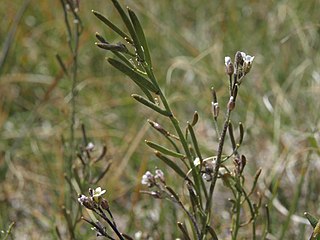
Royal Botanic Gardens, Kew is a non-departmental public body in the United Kingdom sponsored by the Department for Environment, Food and Rural Affairs. An internationally important botanical research and education institution, it employs 1,100 staff. Its board of trustees is chaired by Dame Amelia Fawcett.

Aucuba is a genus of three to ten species of flowering plants, now placed in the family Garryaceae, although formerly classified in the Aucubaceae or Cornaceae.

Paeonia daurica subsp. mlokosewitschii, the golden peony or Caucasian peony, is a species of flowering plant native to the Caucasus Mountains in Azerbaijan, Georgia, and Dagestan, where it grows on rocky slopes in oak, hornbeam, or beech forests. The plant is sometimes nicknamed Molly the witch, a humorous mispronunciation of the species name, which most people find difficult to pronounce. It was formerly regarded as a separate species, Paeonia mlokosewitschii, but in 2002, the Chinese botanist Hong Deyuan reduced it to a subspecies of Paeonia daurica.

Primula matthioli, synonym Cortusa matthioli, sometimes called alpine bells, is a flowering plant with a wide distribution in the Palearctic, both in Europe and in temperate Asia, from Siberia in the north to Afghanistan, Pakistan and China in the south.

Larix potaninii is a species of larch conifer in the family Pinaceae. It is found in China and Nepal. The one of southernmost species of the genus Larix, the range of Larix potaninii extends southward almost to 27° N.
Tricarpelema is a genus of monocotyledonous flowering plants in the family Commelinaceae consisting of 8 species. The genus is divided into two subgenera, subgenus Tricarpelema, which includes 7 known species found in tropical Asia, and subgenus Keatingia with one species in western Africa. The Asian species are typically found in the forest understory while the single African species has evolved to drier, sunnier conditions and is usually associated with inselbergs.
Pseudodanthonia is a genus of Himalayan plants in the grass family. The only known species is Pseudodanthonia himalaica, native to Uttarakhand and Uttar Pradesh in northern India

Lumnitzera racemosa, commonly known as the white-flowered black mangrove, is a species of mangrove in the family Combretaceae. It is found on the eastern coast of Africa and other places in the western Indo-Pacific region. It has one accepted variety from the noniminate species which is Lumnitzera racemosa var. lutea (Gaudich.) Exell.

Osmolindsaea is a genus of ferns in the family Lindsaeaceae. Most species are found in southeastern Asia, from West Himalaya and Sri Lanka to Japan and New Guinea. Osmolindsaea latisquama and Osmolindsaea leptolepida are found in Madagascar and the adjacent African mainland.

Diapensia is a genus of flowering plants of the family Diapensiaceae. Most of the species are found in the Himalayas. Diapensia lapponica has a high Arctic, circumpolar distribution.

Xylanche himalaica is a species of flowering plant in the family Orobanchaceae native to Asia. It was first formally named as Boschniakia himalaica in 1884 and transferred to the genus Xylanche in 1893. It is the only species in the genus Xylanche.
Wulfeniopsis is a genus of flowering plants belonging to the family Plantaginaceae. It is also in Tribe Veroniceae.

Crucihimalaya is a genus of flowering plants belonging to the family Brassicaceae.
Neopicrorhiza is a genus of flowering plants belonging to the family Plantaginaceae.
Pterygiella is a genus of flowering plants belonging to the family Orobanchaceae.
Pseudobartsia is a monotypic genus of flowering plants belonging to the family Orobanchaceae. The only species is Pseudobartsia glandulosa.
Pseudocodon is a genus of flowering plants belonging to the family Campanulaceae.

Phalaenopsis zhejiangensis, also known as 象鼻兰 in Chinese, is a species of orchid native to Thailand and Vietnam. It is firmly established to be within the genus Phalaenopsis. Its extraordinary flowers are white with purple transverse bands on sepals and petals and with purple lip markings. It is a typical epiphytic orchid. It is found at elevations of 300 to 900 m. The specific epithet zhejiangensis refers to this species origin in the Chinese province of Zhejiang. It is closely related to Phalaenopsis wilsonii.

Phalaenopsis yingjiangensis, also known as 盈江羽唇兰 in Chinese, is a species of epiphytic orchid native to China South-Central.
Carex himalaica is a tussock-forming species of perennial sedge in the family Cyperaceae. It is native to parts of Nepal.











